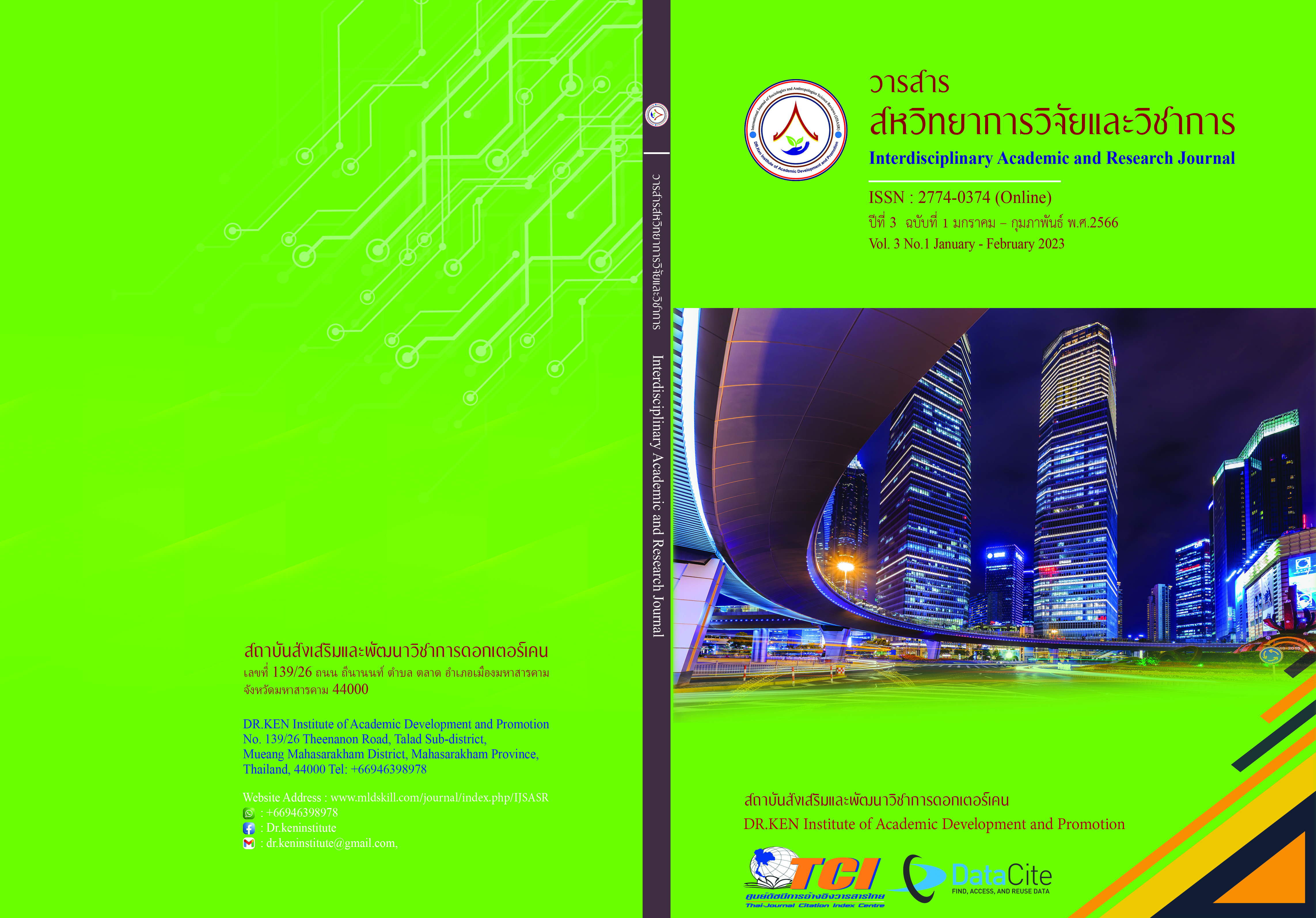Evaluation of the Honest School Project Kalasin Pittayasai School, Under the Office of Kalasin Primary Education Service Area 1
DOI:
https://doi.org/10.14456/iarj.2023.2Keywords:
Project Evaluation; , Honest SchoolAbstract
National Anti-Corruption Strategy Phase 3 (2017 - 2021) Strategy 1 "Create a Thai society that does not tolerate corruption". But starting from the process of socialization at all age levels by implementing projects to promote morality, ethics, and good governance in educational institutions (Honest school project). To lay the foundation for cultivating consciousness which is a mechanism for the prevention and suppression of corruption in the nation (The twelfth National Economic and Social Development Plan, 2016) Kalasin Pittayasap School has therefore assessed the honest school project. The assessment of this project is to evaluate the Honest School Project of Kalasin Pittayasai School under the office of Kalasin Primary Education Service Area 1. Using the assessment CIPPiest model, the group of informants in the project assessment consisted of school administrators 5, teachers in charge of project 3, 89 teachers, and a board of basic education institutions of 13 members. This does not include the school committee who are teachers and school administrators, amounting to 2 people, 537 students in grades 4-6 and parents of 537 students in grades 4-6. The tools used for data collection consisted of 4 project evaluation forms, and an open-ended project evaluation form. The statistics used to analyze the data were Mean, Standard Deviation, and content analysis. Project evaluation results found that : (1) Context Assessment Results of the Honest School Project found that overall was at a high level which passed the specified evaluation criteria. (2) Results of the assessment of the input factors of the Honest School Project found that overall was at a high level and passed the specified evaluation criteria. (3) Evaluation results of the process of the Honest School Project found that overall was at the highest level which passed the specified evaluation criteria. (4) Results of the Productivity Evaluation of Honest School Project found that overall was at a high level and passed the specified evaluation criteria. Considering each section is as follows: (A) Part 1: Effects on students Overall assessment results at a high level. (B) Part 2: Effects on teachers and school administrators' overall assessment results at a high level. (C) Part 3: Effects on Educational Institutions Overall assessment results at a high level.
References
เยาวดี รางชัยกุล วิบูลย์ศรี. (2551). การประเมินโครงการ:แนวคิดและการปฏิบัติ. พิมพ์ครั้งที่ 6. กรุงเทพฯ : สำนักพิมพ์แห่งจุฬาลงกรณ์มหาวิทยาลัย.
โรงเรียนกาฬสินธุ์พิทยาสัย. (2563). กลยุทธ์การบริหารการใช้หลักสูตรต้านทุจริตศึกษาเพื่อเสริมสร้างคุณลักษณะ 5 ประการของโรงเรียนสุจริต. กาฬสินธุ์ : โรงเรียนกาฬสินธุ์พิทยาสัย. พิมพ์ครั้งที่ 1.
กนกวรรณ จันทร์เจริญชัย. (2553). การเตรียมและการประเมินโครงการ. กรุงเทพฯ : ภาควิชาเศรษฐศาสตร์ คณะเศรษฐศาสตร์ มหาวิทยาลัยเกษตรศาสตร์.
บุญชม ศรีสะอาด. (2553). รูปแบบการควบคุมวิทยานิพนธ์ โครงการสถาบันวิจัยและพัฒนาการเรียนการสอนมหาวิทยาลัยศรีนครินทรวิโรฒ.
ประภัสสร วงษ์ดี และคณะ. (2554). การประเมินโครงการตามแนวของ CIPPIEST Model. วารสารครุสาร. 3(1), 84-90.
พวงรัตน์ ทวีรัตน์. (2543). วิธีการวิจัยทางพฤติกรรมศาสตร์และสังคมศาสตร์. สำนักทดสอบทางการศึกษาและจิตวิทยา มหาวิทยาลัยศรีนครินทรวิโรฒ. กรุงเทพฯ: พิมพ์ครั้งที่ 7.
มาเรียม นิลพันธ์. (2554). การประเมินหลักสูตรปรัชญาดุษฏีบัณฑิต สาขาวิชาหลักสูตรและการเรียนการสอน คณะศึกษาศาสตร์ มหาวิทยาลัยศิลปากร. กรุงเทพฯ : มหาวิทยาลัยศิลปากร.
รัตนะ บัวสนธ์. (2556). รูปแบบการประเมิน CIPP และ CIPPIEST มโนทัศน์ที่คลาดเคลื่อนและถูกต้องในการใช้. วารสารศิลปากรศึกษาศาสตร์วิจัย. 5 (2), 7-24.
รัตนะ บัวสนธ์. (2558). วิจัยเชิงคุณภาพทางการศึกษา. กรุงเทพฯ : โรงพิมพ์แห่งจุฬาลงกรณ์มหาวิทยาลัย.พิมพ์ครั้งที่ 5.
รำไพ แสงนิกุล. (2559). การประเมินโครงการบ้านนักวิทยาศาสตร์น้อยประเทศไทย : กรณีศึกษา สำนักงานเขตพื้นที่การศึกษาประถมศึกษากาฬสินธุ์เขต 2. วิทยานิพนธ์ครุศาสตรมหาบัณฑิต สาขาวิจัยและประเมินผลการศึกษา : มหาวิทยาลัยราชภัฏมหาสารคาม.
ศิริชัย กาญจนวาสี. (2552). ทฤษฎีการทดสอบแบบดั้งเดิม. พิมพ์ครั้งที่ 6. กรุงเทพฯ: จุฬาลงกรณ์มหาวิทยาลัย.
สมคิด พรหมจุ้ย. (2552). เทคนิคการประเมินโครงการ. กรุงเทพฯ : สำนักพิมพ์แห่งจุฬาลงกรณ์ มหาวิทยาลัย.
สำนักงานคณะกรรมการป้องกันและปราบปรามการทุจริตแห่งชาติ และสำนักงานคณะกรรมการการศึกษาขั้นพื้นฐาน. (2561). หลักสูตรรายวิชาเพิ่มเติมการป้องกันการทุจริต. กรุงเทพฯ : ชุมนุมสหกรณ์การเกษตรแห่งประเทศไทย.
สำนักงานคณะกรรมการพัฒนาเศรษฐกิจและสังคมแห่งชาติ. (2559). แผนพัฒนาเศรษฐกิจและสังคมแห่งชาติฉบับที่ 12. กรุงเทพฯ: สำนักงานคณะกรรมการพัฒนาเศรษฐกิจและสังคมแห่งชาติ.
สำนักพัฒนานวัตกรรมการจัดการศึกษา. (2555). โครงการโรงเรียนในฝันสู่มาตรฐานสากลภายใต้ โครงการวิจัยและพัฒนานวัตกรรมการบริหารโรงเรียนอย่างยั่งยืนและมีคุณภาพทั้งองค์กร. เอกสารประกอบการบรรยาย. Retrieved on 11 January 2013 from: http://www.labschools.net/docdown/wcl/wcl_labschools.htm
สุพักตร์ พิบูลย์ (2551). กลยุทธ์การวิจัยเพื่อพัฒนางานวิจัยเพื่อพัฒนาองค์กร. นนทบุรี: จตุพรดีไซด์
สุวิมล ว่องวานิช และคณะ (2551). การวิจัยและพัฒนาระบบประเมินภายในของสถานศึกษา. กรุงเทพฯ : อมรการพิมพ์.
อนันตชัย ทองปาน. (2564). การประเมินโครงการยกระดับคุณภาพด้านการอ่าน การเขียน และคิดวิเคราะห์ ของนักเรียนในระดับการจัดการศึกษาขั้นพื้นฐานโดยใช้รูปแบบ CIPPIEST. วิทยานิพนธ์ สาขาวิชาการบริหารการศึกษา : มหาวิทยาลัยราชภัฏรำไพพรรณี.
Kerlinger, F. N. (1973). Foundations of behavioral research. 2nd edition. New York: Holt, Rhinehart, and Winston
Stufflebeam, D. L., & Shinkfield, A. J. (2007). Evaluation theory, models and applications. San Francisco, CA Jossey-Bass.
Stufflebeam, D.L., Gulickson, A., & Wingate, L. (2002). The spirit of consuelo: An evaluation of Ke Aka Hòona. The Evaluation Center, Western Michigan University.
Downloads
Published
How to Cite
Issue
Section
License
Copyright (c) 2023 สุชาติ แวงโสธรณ์

This work is licensed under a Creative Commons Attribution-NonCommercial-NoDerivatives 4.0 International License.
Copyright on any article in the Interdisciplinary Academic and Research Journal is retained by the author(s) under the under the Creative Commons Attribution-NonCommercial-NoDerivatives 4.0 International License. Permission to use text, content, images, etc. of publication. Any user to read, download, copy, distribute, print, search, or link to the full texts of articles, crawl them for indexing, pass them as data to software, or use them for any other lawful purpose. But do not use it for commercial use or with the intent to benefit any business.
















.png)


